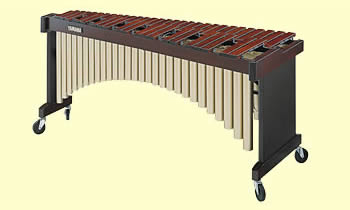The Structure of the Marimba
Inside and outside the resonator pipes
What is the sound like without a resonator pipe?
Beneath the tone plates of a marimba, metal resonator pipes are affixed. Attached to every tone plate is one pipe, which makes the note resonate fully when the bar is hit with a mallet. The length of the resonator pipe also changes depending on the pitch of the tone plate. The lower the note, the longer. If there were no resonator pipe, there would just be a soft popping sound when the wooden bar was hit. As an experiment, try listening to the instrument the normal way, with the resonator pipe attached, and also with it removed.
With the resonator pipe (normal)
Without the resonator pipe
One end is closed off!
The inside of a resonator pipe is hollow. The opening directly beneath the tone plate is open, but the one far from the bar is closed. The pipe makes the air inside vibrate and resonate. Actually, it would resonate even without one end being closed off, but that would require a pipe twice the length. This would make the instrument very large, so one end is closed off.
Some of the pipes are decorative?
Marimbas are made with a focus on creating the visual effect of beautiful rows of pipes shining on the stage. As a result, on some instruments, pipes are added where there are no tone plates. In other words, these are decorative pipes. However, even these do play a role in resonating the notes produced by neighboring tone plates. If the resonating is truly unwanted, then a lid can be put on top, adjusting the pipe to make it as if it were not there at all.

Resonator pipes sometimes have no tone plates above them (left), or are covered with lids (right)
In pursuit of exterior beauty
Some marimbas have the pipes lined up with left-right symmetry, creating an arch shape. With these, the pipes are closed off midway, and, just as with a marimba not designed to have this arch, the effective length of the pipe is shorter the higher the note. The arch is there because the designer intends the instrument to look to be left-right symmetrical.

A marimba whose resonator pipes form an arch
Musical Instrument Guide : Marimba Contents
Origins
Structure
- What kind of instrument is the marimba?
- Inside and outside the resonator pipes
- There is craft to the design of the tone plates, too
- [Experiment1]Tone plate sanding depth and sound pitch experiment
- [Experiment2]Tone plate sanding location and sound pitch experiment
- [Experiment3]Try changing the material of the resonator pipes
